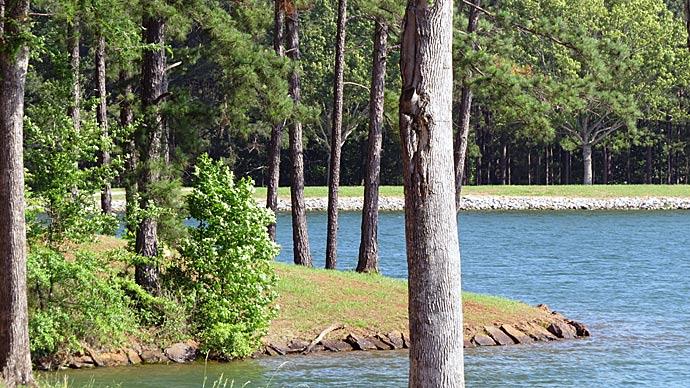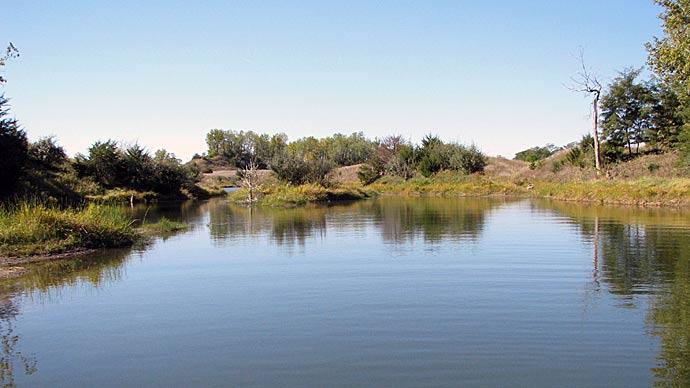You've done your homework. You have examined and evaluated your site, mapped the area, dug your test holes, found good soils to hold water and you have flagged the eventual shoreline. In between, have walked over and over your site, figured your elevations and water depth.
Now, it's time to get the shovel and turn some dirt. The real fun begins.
There are several ways to start, and many ways to proceed. But, everything you need to know about moving dirt parallels a shovel, and a bucket.
Learn the tools of dirt moving tradesmen, and tricks of the trade. By now you have already taken steps to pick the best contractor for your project. Here are a few tips:
Do it yourself, live and learn. Picking up new information should be stimulating, as long as you're not trying to learn to circle the moon. Look back at Steve Cody, from middle Oklahoma. He built a 30-acre lake, virtually by himself. Cody bought a dozer, and worked after hours and weekends to build his dream lake. It came out great.
Steve had so much fun, he's planning another one. But, Steve Cody can do that. He's in the ranching business, builds big grain bins, and understands heavy equipment and dirt. He was raised with dirt.
If you don't have the time, or don't like to have fun, call me. If I'm too expensive, find someone else who has the time and thinks it's fun.
The key is finding someone who is easy to work with and thinks planning is important. We are building a fishing lake here, not a farm pond.
Look for experience. Find someone who has done your type of project. Ask for references, and follow-up. Don't be afraid to look at projects he has done. You are spending big money, and confidence in the contractor is crucial. Experience is important, but all lakes are different, and new situations are encountered all the time. Daily adjustments are nearly always the rule.
So, your contractor should be light enough on his feet to recognize change, and communicate with you when it's time to vary the game plan. For example, a recent project we had in northern Texas was interrupted by heavy rain, which meant saturated soils and water backed half way up the unfinished project. The problem? Water sits where underwater fish cover should stand.
The land owner was troubled, and the contractor was ready to rent an expensive pump. The two got their heads together, thought about the problem, and came to a basic conclusion. The "lake" would drain two feet without pumping. The borrow areas, where the contractor was bringing clay, was above the new water line. Once finished, the lake would be another 14 feet deeper. The decision was made to leave the water alone.
The landowner didn't want cover in water deeper than 10 feet, anyway. So, the lake dropped, and the contractor went back to work. The water truck didn't have to travel far to get water, and earth-moving equipment wasn't hampered. The landowner has enough water to stock fish, once the project is completed. End of problem.
Try to find a contractor who works locally. Local people know local soils, and understands an area you may not be too familiar. Talk to people, neighbors and friends. Go to the local restaurant or coffee shop and ask who builds ponds. Call the NRCS (Natural Resources Conservation Service). Compile a list of candidates. Also, call equipment dealers and equipment leasing companies. They always know who can't pay their bills. Scratch those candidates off your list.
Groom your list. Typically, you'll find two or three excellent candidates. Call and listen to them. Hear their experiences, and talk. Meet your candidates on site, then get something in writing, Ask for bids, pin them down best you can. Go look at the work they've done, and talk with their clients. (But, always, always call me first.)
Beware the lowest bid, beware the highest. If a bid is too good to be true, it's too good to be true. Anyone who bids earthmoving below ground, without studying sub-soils, is foolish. Anyone who makes a guarantee that a pond will fill up, or hold water like a glass jug may not be thinking straight, unless there's too much water coming down the creek. Beware of people who can give a definite answer on a marginal site. There are precious few stone-cold absolutes in pond building.
Building a fishing pond or lake may be fun, but rarely is it easy. The "right" contractor has the "right" equipment to do your job. Equipment are tools, trackhoe, bulldozer, backhoe, water truck, scraper, motor grader. Tools, that's it. But, the proper equipment, with experienced operators, are crucial to the financial well being of your lake site. Know the equipment, and purpose.
A trackhoe, or excavator, digs a deep trench faster than other equipment, but will only, move dirt 20 feet, A trackhoe moves much more dirt than a bulldozer, is good in mud, and attractive for places hard to reach.
Even though a dozer can't dig as fast as a trackhoe, they can move dirt much farther, 100-150 feet. Dozers often have to remove dirt a trackhoe has dug, to a proper place. Dozers have trouble moving in mud.
Scrapers will haul dirt farther and faster than a dozer, but must have a hard surface to be efficient. Sometimes a scraper is loaded with a trackhoe, and often pushed with a dozer to get the boost it needs to move heavy loads.
Dump trucks, off-road trucks are often used to move dirt from one point to another, especially when renovating old ponds full of silt.
Use a dozer on small jobs, because it is the most cost efficient piece of equipment, add a scraper on bigger projects, to move dirt farther. Different dozers do different work. Big dozers move big dirt, but are clumsy when it comes to finish work. Smaller dozers are excellent to finish and sculpt.
Dozers with loader buckets are good for moving mud, but not efficient to process soils for a dam site. Swamp dozers have wide tracks, and can move on top of less stable soils, especially when it comes to clearing brush from moist soils.
Pick the right tools for your job. Once you start moving dirt, put it where it goes, so it's only moved once. It costs money every time dirt's moved somewhere, kinda like going on vacation. That money's gone. Don't make a tourist out of your dirt.
Dirt in a dam must be "processed." Material needs to be placed in the proper spot, clay in the core trench and up through the center, and front of the dam, less desirable material can be pushed and compacted in the back half of the dam.
Ahhh, compaction. Processed, pulverized, watered, stomped until each tiny particle is squashed on top of its nearest friend. Dirt stuck together against a mighty cause, water.
Once dirt's placed, compact. Loose dirt allows water to pass through. Remember this, dirt must have some moisture for all particles to fit together as close as possible. Water trucks, pump and hose, or the big water truck in the sky are tools to aid in compaction. In the best world, dirt being moved has enough moisture already so we don't need to add any.
Dry material won't compact sufficiently. Dirt compacts better when spread evenly and pulverized. Get rid of large clods or rocks.
A disc is often used to mix and pulverize. Contractors can also use motor graders, dozers, box blades.
Dirt's wet, mixed, pulverized, and now must be packed together as tightly as possible in your dam site.
The best way to pack dirt is pure force, weight. Sheepsfoot vibrating packer, scraper with a load of dirt, dump truck, loader tractor with a full bucket, can all be used to pack dirt. Know compaction, no leak. No compaction, big leak.
What about other equipment? Digging a small trench? Use a backhoe. Backhoes help lay pipe. It's a good little utility vehicle for moving rocks, small trees, brush piles into position, or setting stumps in that perfect little "slice of fish paradise."
Once upon a time I took on a new job in a new area. I had recently launched my very own earth-moving business and was taking on new clients. This particular landowner, an old German farmer with lots of kids, needed a small stock pond, but only if it would hold water. He wasn't about to waste any money. He wasn't much of a talker, but I let him know a few things about moving dirt. I started digging and, boy, did it look good. I was young and dumb enough to tell this old fellow that this pond would be a good one. I guaranteed it.
First time it rained, the pond filled. By the next morning, the pond was empty.
Actually, the water wasn't really missing, it was sitting in his cornfield just downstream from the dam. The water I had promised would be in the pond was flooding two acres of corn.
The old German was upset. He was so upset he didn't even go to his daughter's wedding. It hurt her feelings tremendously. But, I was glad he didn't go. No use me suffering on my wedding day, too. I married his daughter.
After the wedding, the pond matured, and started holding water. He still doesn't talk much. But he has a good pond now.
Sometimes the big engineer in the sky will give a guy a break. I'd been in business about 15 years, been everywhere and had seen it all. And, I was not one bit afraid to let you know how much I knew.
The call came from nowhere, a nice guy and his brother wanted me to build a road and small lake. He told me it would be a simple job, no need to even look at it. I checked my maps, but mainly, I thought I knew enough and had seen enough of nearby land to bid this one from my house. After all, he had heard of me, and wanted me to do his work.
I found out later I was at least the third person he had called, and the only one who didn't go look at the site. All his neighbors and the other contractors wondered how my new admirer got anybody to agree to build anything in a place that usually looks like Texas' best imitation of the Everglades. By the grace of God, this was the driest year in history, right behind the second and third driest years in history. It was the only time before and since that anyone has been able to walk through this area, much less put equipment in it.
Fast Eddie and his brother Big Dave had been trying to get someone for years. I should've known something was up when he told me he would pay me in full the day the job was completed. He knew it probably would never be done. Figured I would get half through and it would rain. Then, it would be the next drought before I could finish. By the grace of God, it stayed dry enough to build a fairly nice lake and road through that forsaken low spot.
Go build a lake. Next time, we'll look at the finer aspects of moving dirt, reading soils as they're uncovered. We get into sculpting the bottom, creating the best fish cover, and team up with biologists who have different ideas how fish live under water. Get ready to create underwater condos, social gathering points, spawning beds and fish attractors.
Until then, always remember that, if you want to get along with your father-in-law, don't build him a pond.
Reprinted with permission from Pond Boss Magazine


